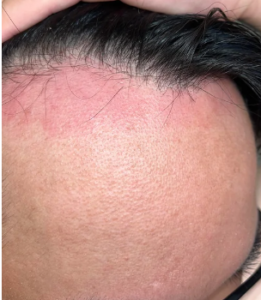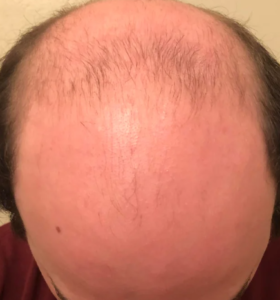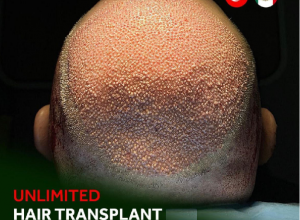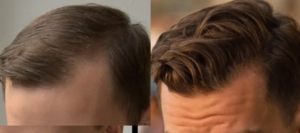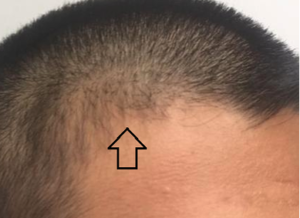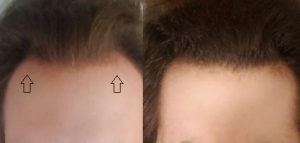Does someone with miniaturized hair who either has shock loss from transplant surgery or accidentally had their miniaturized hair pulled out will finasteride help to regrow them? Or once they’re out, that’s it; the follicle dies, and there can be no more growth?
Miniaturized hair loss from surgical hair transplant shock loss often does not return; however, if that person was on finasteride before the transplant, the miniaturized hairs are prevented from shock loss. If one pulls out miniaturized hairs (I can’t imagine doing this), these hairs may return.
8 months on 5mg fin daily, 5% min twice daily, and hrt(mtf). Thought my hair was unrecoverable before but now I’m so happy.
This is an amazing change. I would like to know how old you are now and how many years you have been so bald. Time is usually a key here because scientists believe that long-term balding like this, greater than 15 years, has already lost its stem cells. With my new company Amplifica which some of you know about, once we know our drug works, then we will tackle some of the longer-term balding patients like you. Also, I would expect the HRT to hamper the growth so I would be wrong here. Congrats.
I have been taking oral finasteride and topical minoxidil for three months. One question, how long can I expect finasteride and Minox to keep my hair around. Since I’m pretty early on in life, I’m worried they’ll grow less effective the more I take them. But, I just don’t know how it works. Is my responding well a good indication they may last longer? I’m hoping to keep my hair for as long as possible, none of this “I’m aiming for 40”, I’m aiming for until I’m on my deathbed and the doctors forget to administer it.
These drugs should keep working; no guarantee, however. I have seen Finasteride go easily 25 years and still hold on to those men’s hair. I would expect minoxidil to do the same, but I don’t have personal experience with it for 25 years as I have with finasteride.
I had good hair until 35 almost 36 when my hair started to aggressively thin. Started fin in 2019. The regrowth hasn’t been as good as I would have liked. My crown had never experienced any major balding like my front did. Finasteride has definitely stopped the aggressive progression but only some mild regrowth. Not sure if I should up my dose or switch to something else.
The most effective dose is 1mg for finasteride. If this doesn’t meet your needs, add microneedling and possibly oral minoxidil. With all of your hair loss occurring in the past 3-4 years, you should be responsive to reversal with some combination of these approaches. I generally believe that these medical approaches work best on recent hair loss.
Hi there Dr. Rassman. I’ve been reading the balding blog and think it’s great!
I have a question for the blog. Do thinning areas of the scalp (regardless of what the Norwood pattern is) always eventually thin to the point where that area ends up completely shiny bald and there is no hair left in that area at all? Or can a thinning area thin to a certain degree and then stabilize like that with some hair remaining in the thinning area? So like for a example, would a person with a Norwood 6 pattern always end up completely slick bald? Or can the hair significantly thin in the Norwood 6 pattern but then stabilize with some hair remaining within that pattern?
If a person is thinning in a Class 6 pattern, for example, then if the thinning (when looked at under a hand microscope) has significant miniaturization, then one can expect eventual progression to a full Class 6 pattern; however, if there is just uniform reduction in shaft sizes even in the donor area (again using a hand microscope), then this is a condition called Age Related Thinning.
I do not doubt that these people will deliver on this promise, but at what cost? Your out-of-pocket costs will be a bargain, but the following are real risks if you take up the ad and get a hair transplant from these folks
1- Your donor area will be depleted, and you are probably going to be bald around the side and back of the head
2- You may be over-treated with anesthetic and may not live through the surgery
3- The grafts may not grow because they were not handled properly
4- You may end up with necrosis in some of the transplanted recipient areas
5- Highly likely these are not doctors offering the service
As minoxidil-dependent hair needs minoxidil, stop it two days before your transplant and restart it two weeks later. That is my usual recommendation. If you don’t restart it, you may continue to lose minoxidil dependent hairs.
Does finasteride eventually stop working over time to either regrow or maintain hair for everyone that takes it as their genes for balding take over?
Finasteride maintains benefits; however, your hair’s ability to stop its eventual pattern may not be stopped by finasteride, just slowed down. I have seen men on finasteride for 15-20 yrs stop it, and they lost significant amounts of hair as a result suggesting even that far out (20 years) doesn’t stop finasteride’s effectiveness
Microneedling can work independently of medications but could be a better or faster response.
Asking a bald person that question is great. We know finasteride slows balding down and can reverse it in men under 25 with some predictability. The problem is: At 18, many men don’t show balding. But if you start taking finasteride when a man notices it, it will likely change the course of the balding, possibly stopping it.
If you are going to take minoxidil pills, there is no need for the topical.
Note that this young man has a widow’s peak, which is a remnant of his juvenile hairline. He also has his corner hair from his juvenile hairline, which appears to be weaker and will eventually fall out as his hairline takes on a “V” shape (see arrow). Some men falsely think that this is balding, but I tell them that this is a maturing hairline is process.

